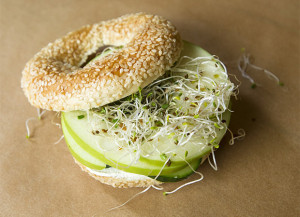I know lots about the social amplification of risk as promoted by Kasperson, et al., but I’m not sure the author a new paper examining that theory in Germany’s 2011 E. coli O104 outbreak involving sprouts does.
 Lots of risk communication background, not much in the way of what to do. But, you can decide.
Lots of risk communication background, not much in the way of what to do. But, you can decide.
The social amplification of risk framework highlights the role which the news media play in risk communication by interacting with other agents in amplifying risk. However, the precise ways in which the media and other social agents actually amplify risks in public debates are unclear. In this article we draw on insights from the sociology of news to examine whether and to what extent social agents and news media amplify an emerging health risk. We use the debate about the Escherichia coli outbreak in Germany in 2011 to examine three issues: the amount of risk reporting by news media and social agents in their function as news sources; their evaluation of risk; and how they contribute to the escalation of risk, also known as ripple effects. In this article we draw on data from a content analysis of press releases from public health authorities and affected stakeholders and of news items in leading German news media. We found that the affected stakeholders were amplifying the risk to the greatest extent. We also found that there was a shift over time in the use of dominant frames. At the start of the debate the risk was framed as a public health issue and linked to medical-scientific progress. As the debate developed, more attention was given to political and economic consequences of the outbreak and the original health risk event was layered by other risk-related events.
Social agents and news media as risk amplifiers: a case study on the public debate about the E. coli outbreak in Germany 2011
Health, Risk & Society, August 20, 2014
Juliana Raupp
http://dx.doi.org/10.1080/13698575.2014.950203
 We did our own take on the sprout-related literature a couple of years ago and concluded:
We did our own take on the sprout-related literature a couple of years ago and concluded:
• raw sprouts are a well-documented source of foodborne illness;
• risk communication about raw sprouts has been inconsistent; and,
• continued outbreaks question effectiveness of risk management strategies and producer compliance.
We document at least 55 sprout-associated outbreaks occurring worldwide affecting a total of 15,233 people since 1988. A comprehensive table of sprout-related outbreaks can be found at https://barfblog.com/wp-content/uploads/2014/08/Sprout-associated-outbreaks-8-1-14.xlsx.
Sprouts present a unique food safety challenge compared to other fresh produce, as the sprouting process provides optimal conditions for the growth and proliferation of pathogenic bacteria. The sprout industry, regulatory agencies, and the academic community have been collaborating to improve the microbiological safety of raw sprouts, including the implementation of Good Manufacturing Practices (GMP), establishing guidelines for safe sprout production, and chemical disinfection of seed prior to sprouting. However, guidelines and best practices are only as good as their implementation. The consumption of raw sprouts is considered high-risk, especially for young, elderly and immuno-compromised persons.
From November 2010 into 2011, an outbreak linked to raw sprouts in the U.S. and involving sandwich franchise Jimmy John’s sickened 140 people. This was the third sprout related outbreak involving this franchise, yet the owner of the Montana Jimmy John’s outlet, Dan Stevens, expressed confidence in his sprouts claiming that because the sprouts were locally grown they would not be contaminated. By the end of December 2010 a sprout supplier, Tiny Greens Farm, was implicated in the outbreak. Jimmy John’s owner, John Liautaud, responded by stating the sandwich chain would replace alfalfa sprouts with clover sprouts since they were allegedly easier to clean. However, a week earlier a separate outbreak had been identified in Washington and Oregon in which eight people were infected with Salmonella after eating sandwiches containing clover sprouts from a Jimmy John’s restaurant. This retailer was apparently not aware of the risks associated with sprouts, or even outbreaks associated with his franchisees.
In late December, 2011, less than one year after making the switch to clover sprouts, Jimmy John’s was linked to another sprout related outbreak, this time it was E.coli O26 in clover sprouts. In February 2012, sandwich franchise Jimmy John’s announced they were permanently removing raw clover sprouts from their menus. As of April 2012, the outbreak had affected 29 people across 11 states. Founder and chief executive, John Liautaud, attempted to appease upset customers through Facebook stating, “a lot of folks dig my sprouts, but I will only serve the best of the best. Sprouts were inconsistent and inconsistency does not equal the best.” He also informed them the franchise was testing snow pea shoots in a Campaign, Illinois store, although there is no mention regarding the “consistency” or safety of this choice.
 Despite the frequent need for sprout-based risk communication, messaging with industry and public stakeholders has been limited in effectiveness. In spite of widespread media coverage of sprout-related outbreaks, improved production guidelines, and public health enforcement actions, awareness of risk remains low. Producers, food service and government agencies need to provide consistent, evidence-based messages and, more importantly, actions. Information regarding sprout-related risks and food safety concerns should be available and accurately presented to producers, retailers and consumers in a manner that relies on scientific data and clear communications.
Despite the frequent need for sprout-based risk communication, messaging with industry and public stakeholders has been limited in effectiveness. In spite of widespread media coverage of sprout-related outbreaks, improved production guidelines, and public health enforcement actions, awareness of risk remains low. Producers, food service and government agencies need to provide consistent, evidence-based messages and, more importantly, actions. Information regarding sprout-related risks and food safety concerns should be available and accurately presented to producers, retailers and consumers in a manner that relies on scientific data and clear communications.
Erdozain, M.S., Allen, K.J., Morley, K.A. and Powell, D.A. 2012. Failures in sprouts-related risk communication. Food Control. 10.1016/j.foodcont.2012.08.022
http://www.sciencedirect.com/science/article/pii/S0956713512004707?v=s5
Abstract
Nutritional and perceived health benefits have contributed to the increasing popularity of raw sprouted seed products. In the past two decades, sprouted seeds have been arecurring food safety concern, with at least 55 documented foodborne outbreaks affecting more than 15,000 people. A compilation of selected publications was used to yield an analysis of the evolving safety and risk communication related to raw sprouts, including microbiological safety, efforts to improve production practices, and effectiveness of communication prior to, during, and after sprout-related outbreaks. Scientific investigation and media coverage of sprout-related outbreaks has led to improved production guidelines and public health enforcement actions, yet continued outbreaks call into question the effectiveness of risk management strategies and producer compliance. Raw sprouts remain a high-risk product and avoidance or thorough cooking are the only ways that consumers can reduce risk; even thorough cooking messages fail to acknowledge the risk of cross-contamination. Risk communication messages have been inconsistent over time with Canadian and U.S. governments finally aligning their messages in the past five years, telling consumers to avoid sprouts. Yet consumer and industry awareness of risk remains low. To minimize health risks linked to the consumption of sprout products, local and national public health agencies, restaurants, retailers and producers need validated, consistent and repeated risk messaging through a variety of sources.
 Productivity may go down so safety corners are cut.
Productivity may go down so safety corners are cut.














